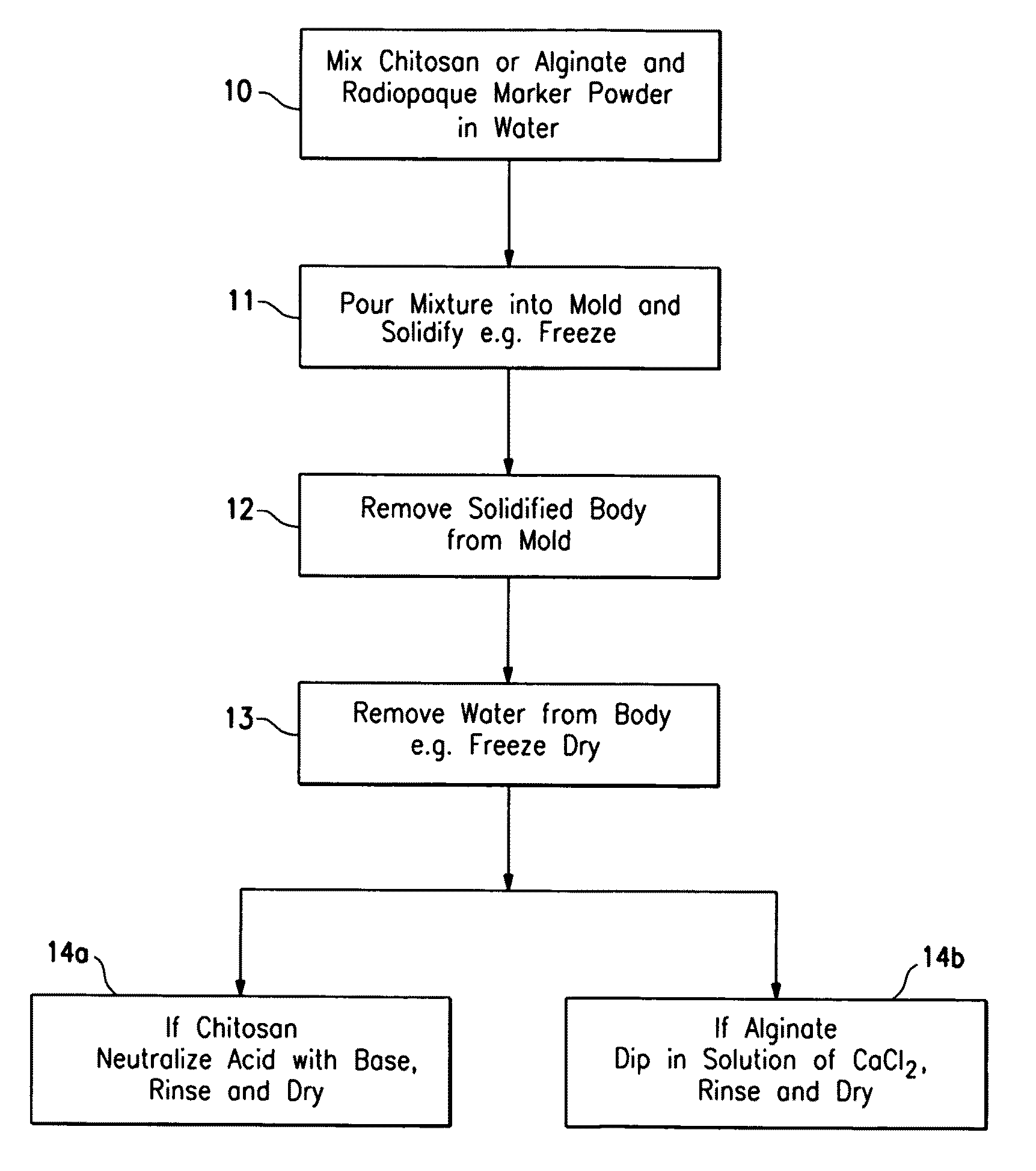Porous bioabsorbable implant
a bioabsorbable, porous technology, applied in the field of porous bioabsorbable implants, can solve the problems of few successful commercialization, few implants have met with significant commercial success, and the effect of easing dosage determination and simplifying irradiation patterns
- Summary
- Abstract
- Description
- Claims
- Application Information
AI Technical Summary
Benefits of technology
Problems solved by technology
Method used
Image
Examples
example i
[0026]An acidic aqueous solution (12.5% acetic acid) was prepared containing 4% by weight chitosan and 2% by weight barium sulfate. The solution was placed in a spherical mold and was then frozen in the mold at −30° C. for 16 hours. The frozen body was removed from the mold and lyophilized for 3 days to remove water. The lyophilized body was neutralized in a 10% solution of ammonium hydroxide for one hour and then rinsed free of the ammonium hydroxide with deionized water. The body was vacuum dried for 16 hours. The body had the spongy consistency approximating breast tissue and had sufficient compressive strength to support breast tissue surrounding a lumpectomy cavity. It comprised 67% chitosan and 33% barium sulfate. An SEM micrograph (30×) of the surface porosity is shown in FIG. 6 and an SEM micrograph (30×) of the central porosity is shown in FIG. 7. The implant had the spongy consistency approximating breast tissue. The implant could be made harder by increasing the amount of...
example ii
[0027]A quantity of sodium alginate (0.5 to about 4% (wt.)) is dissolved in water to form a paste, viscous fluid or gel and air or other biocompatible gas is introduced into the mixture. The mixture is placed in a mold of a desired implant shape and then freeze dried or air dried in the desired shape. The formed implant structure of sodium alginate is introduced into a solution of calcium chloride (0.5 to about 4% (wt.)) where at least part of the sodium alginate is converted to calcium alginate which precipitates. The precipitated porous structure of the implant is introduced into a body cavity from which tissue has been removed. The implant remains at the site for sufficient period of time so as to act as scaffolding to facilitate tissue in-growth within the body cavity. Starch, such as corn starch in finely divided particulate form, can be incorporated into the sodium alginate-water mixture so that when the calcium alginate is formed, it precipitates about the starch particles to...
example iii
[0028]This example is similar to Example II except 30 grams of salt (NaCl) granules are mixed with about 30 ml of 3% (wt.) sodium alginate aqueous solution. The solution placed in a spherical mold and then is frozen for 4 hours. The frozen implant was removed from the mold and placed in a 2% (wt.) calcium chloride solution, forming calcium alginate gel and dissolving at least some of the incorporated salt granules to form a porous structure. The implant had the spongy consistency approximating breast tissue. The implant could be made harder by increasing the amount of sodium alginate in solution, decreasing the amount of salt or decreasing the size of the salt granules.
PUM
 Login to View More
Login to View More Abstract
Description
Claims
Application Information
 Login to View More
Login to View More - R&D
- Intellectual Property
- Life Sciences
- Materials
- Tech Scout
- Unparalleled Data Quality
- Higher Quality Content
- 60% Fewer Hallucinations
Browse by: Latest US Patents, China's latest patents, Technical Efficacy Thesaurus, Application Domain, Technology Topic, Popular Technical Reports.
© 2025 PatSnap. All rights reserved.Legal|Privacy policy|Modern Slavery Act Transparency Statement|Sitemap|About US| Contact US: help@patsnap.com



